Equine tendons and ligaments
Flexural limb deformities
Flexural deformities occur in the sagittal plane (forward and backward movements). These are typically associated with tight tendons, ligaments or joint capsules that restrict stretch.
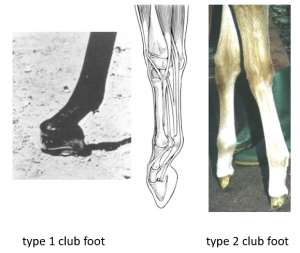
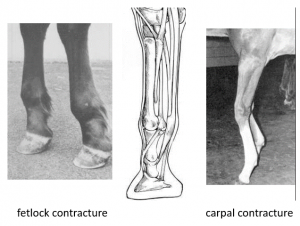
These deformities may be either congenital or acquired and are blamed on “tight tendons”. Contracture of the deep digital flexor tendon pulls on the coffin bone (club foot), while contracture of the superficial flexor tendon pulls on the fetlock (fetlock contracture). Joint capsules may also be tight, leading to all three forms. The pathogenesis of congenital forms is discussed in the next chapter. Acquired deformities are believed to occur secondary to fast growth and a high nutrition plane. Most acquired forms occur in older foals and weanlings but can occur in 1-2 year olds. Fetlock contracture is most commonly seen as an acquired condition and is also the most common acquired contracture!
Club feet (contracture of deep digital flexor tendon; DIP joint flexion)
- The feet look like clubs because the heels grow toward the ground; this causes long heels and relatively short toes.
- DDFT (deep digital flexor) is the only tendon involved in most cases
Fetlock flexural deformity
- Either the SDF (superficial digital flexor) or both the SDF and DDF may be involved
Carpal contracture
- Likely tight joint capsule
*Many cases will also develop rupture of the common digital extensor tendon. This results in a nonpainful soft tissue swelling below the carpus. The rupture does not worsen the prognosis but is associated with a longer duration of therapy. No specific treatment is required.
Medical therapy – congenital forms
Limb bandage or splint
These therapies relax the tendons through the weird relaxation response in babies. Neonatal muscles, tendons and ligaments relax when supported by bandaging, splinting or casting. The firmer the bandage, the more relaxation is achieved. The same response is seen when young animals require a cast. Casted limbs are very relaxed or “noodly” when the cast is removed. The effect decreases with age.
Hoof trimming
The heel should be rasped or trimmed to allow the heel to drop when the tendons relax.
Oxytetracycline
The tetracycline drugs bind calcium and can relax the muscular part of the tendon. This therapy works in the very young and is typically combined with limb bandaging as the response is time limited. If left unbandaged, the limb will return to its contracted state when the drug wears off. Tetracycline causes relaxation only in very young animals, rapidly losing efficacy as animals age. Most will respond well at day 1-3 of age and minimally by 14 days of age.
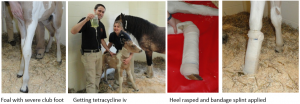
Exercise
Exercise and physical therapy may be enough to stretch structures in mildly affected foals. The exercise encourages normal function. Exercise should be controlled and not overdone. Painful animals will contract the limb, preventing the relaxation needed.
Analgesics
Foals have to walk on these limbs to improve the conformation; if uncomfortable, they won’t walk enough and further tendon contracture may occur due to the withdrawal reflex (aka hot stove reflex)
Medical therapy – acquired forms
Dietary management
Often these foals are on a high plane of nutrition for rapid growth. This results in a mismatch between tendon length and bone length. It is imperative to slow growth rate but without starvation. Starvation results in a compensatory growth spurt once food is reintroduced.
Eliminate the cause
Pain may be a cause of contracture (withdrawal reflex). Check for hoof abscesses and fractures of P3 if the contracture is acquired. If you don’t eliminate the source of pain, no therapy will help.
Note: Oxytetracycline and bandaging are usually ineffective in this age group.
Surgical therapy
Club foot
Cut the inferior (distal) check ligament to allow more stretch of the DDF tendon. This is not a tiny ligament (see image below). Cutting it makes a difference.
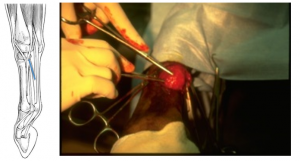
- Excellent prognosis for general work if the deformity is not >90 degrees joint flexion. A decrease in sport horse performance and career longevity may be associated.
- This procedure can be performed in any age horse to improve hoof-pastern angle
- Bandaging and hoof trimming are also required peri-operatively.
- If the contracture is >90 degrees of joint flexion, the deep flexor tendon must be cut. This is a salvage procedure.
- Iodine deficiency in the mare can lead to growth abnormalities in the foal. If the foal has contracted joints, check for an undershot jaw. Those foals have a much more guarded prognosis due to overall lack of response to treatment for the joint contracture.
Fetlock flexural deformity
- Cut the proximal and distal check ligaments
- Poorer prognosis than club feet but should gain some improvement with surgery, especially in young foals
- Older horses can have the surgery but get less release and have more scarring (unsightly)
Carpal contracture
- No good surgical options although cutting the ulnaris lateralis and flexor carpi ulnaris muscles has been used occasionally
Prognosis
Prognosis depends on which joint is flexed and how much contracture is present. In general, the more distal the contracture, the better the prognosis : foot >fetlock > carpus. However, if the foot is flexed so that the angle between P2 and P3 is > 90 degrees, these can be hard to fix. Young horses have a better prognosis for return to normal angulation than older horses.Sport horses needing a check ligament desmotomy were found to have a decreased long-term career compared to matched horses that didn’t have indications for surgery.
Calves tend to have joint capsule contracture and a poorer prognosis.
Key Takeaways
Contracted tendons are generally more readily fixable in babies. After that it gets harder. Not all babies can be fixed.
Club feet are easier to treat than fetlock contracture. Treating carpal contracture in older animals is really hard. There is no good surgery for carpal contracture.
Oxytetracycline and bandaging have magical powers but just in babies.
Foals with contracted tendons and undershot jaws may have dams with iodine deficiency. These foals have a poor prognosis.
Fast growing weanlings and young horses can develop fetlock contracture.
Resources
Long-term athletic performance in sport horses after desmotomy of the accessory ligament of the deep digital flexor tendon. Equine Vet J. 2022;54:495–501.
Types of crooked legs in foals, UMN extension, reviewed 2021
Mindmaps
- Differentials (ald mindmap pdf)
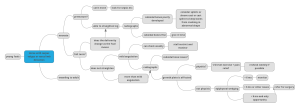
- Treatment

tightening of the tendons leading to a bowing effect of the limb
the joint is bent (flexed) and cannot be straightened

